NHL News
2025-26 Opening Night Roster LTIR Projections
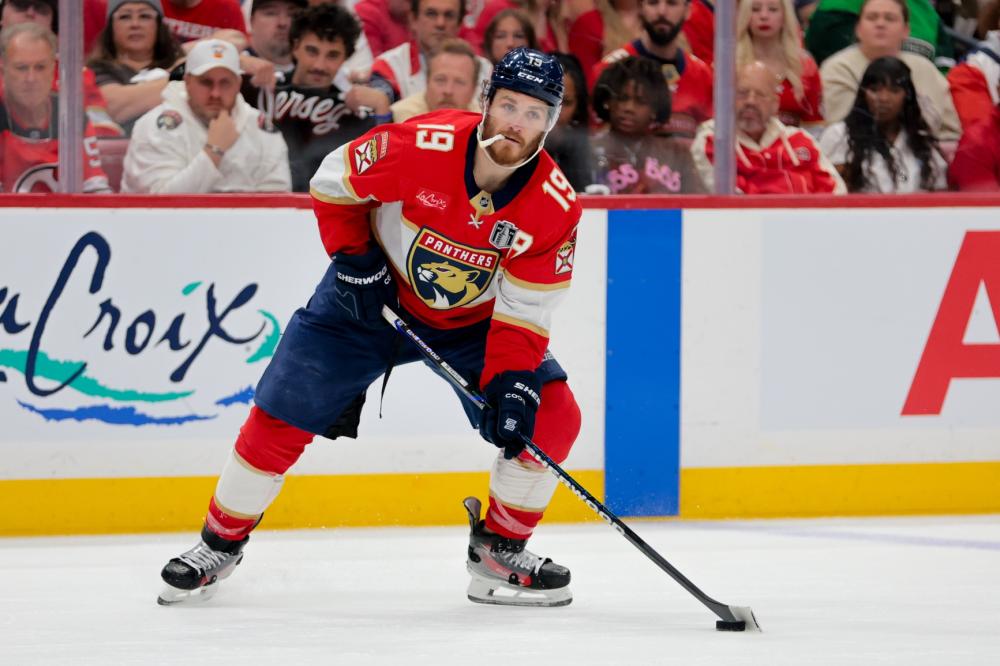
Image © Sam Navarro-Imagn Images
Projecting how teams will set their roster to best utilize LTIR
Welcome to the annual PuckPedia LTIR prediction article, where we attempt to predict how teams will set their rosters up for the NHL’s opening roster submission to optimize LTIR and their cap space.
Last season there were 20 teams that placed players on long-term injured reserve (LTIR), which was down from the previous season’s record of 22. With the cap increasing by more each year than previously, we’ll likely see less teams utilize LTIR. Early indications support that as only a handful of teams look poised to start the season by using LTIR, which is a major reduction from previous years.
LTIR is one of the most cited, impactful, and yet misunderstood acronyms in the NHL’s salary cap era.
But first, a quick refresher on how LTIR works…
What is LTIR?
When a player is injured and expected to miss at least 10 NHL games AND 24 days of the NHL regular season, they are eligible for placement on LTIR. While a player is on LTIR, their team may exceed the salary cap.
Despite the common misconception, a player on LTIR does not have their cap hit removed from the team’s cap total. LTIR allows the team to potentially exceed the cap by an amount commonly referred to as the “LTIR Pool.”
New Rules
The LTIR changes in the new CBA are going into effect for this 2025-2026 season. This created 2 types of LTIR:
- LTIR for players that are returning at some point: The maximum amount that a team can exceed the cap by for an injured players is limited to the league average salary from the previous year ($3,817,293 for 2025-26); this is the “LTIR Benefit Limit”
- Season Ending LTIR (SELTIR) for players that are out through the playoffs: If a player is injured and out for the rest of the season, the team can exceed the cap by up to the injured player’s cap hit. If the team uses this designation, the player is ineligible to return at any point in the regular season or playoffs.
How much can the LTIR team exceed the cap?
There are two methods for determining a team’s LTIR Pool, which is how much they can exceed the cap.
1. If a team is under the cap prior to placing the player on LTIR, then the LTIR pool is the injured player’s cap hit (to the LTIR Benefit Limit of $3,817,293 unless the player is on SELTIR) minus the team cap space available at the time. For example, if a player with a $4 million cap hit goes on LTIR, and their team has $100,000 of cap space, the team’s LTIR pool would be $3.717 million ($3,817,293-$100,000). Because of this, teams often make several roster moves right before a player goes on LTIR to be as close to the cap as possible to maximize their LTIR Pool.
2. If a team is over the league’s $95.5 million cap when they submit their opening roster, their LTIR pool would be the amount they exceed the cap. For example, if a team is $3 million over the cap and places a player on LTIR with a $4 million cap hit, their LTIR Pool would be the $3 million they exceed the cap. Once this method is used, the team starts the season with $0 cap space until more roster moves are made.
This is why a potential LTIR team tries to be as close as possible to the cap ceiling (method 1) or be over the cap by an amount close to the injured player’s cap hit (if the cap hit is under the LTIR benefit limit or the player is on SELTIR) or to the LTIR benefit limit of $3,817,293 (method 2) for their opening roster submission.
Once a team’s initial LTIR pool is established, any additional players going on LTIR throughout the season have their cap hit added to the existing LTIR pool.
Consequences of using LTIR
While using LTIR allows a team to exceed the cap, there are some negative consequences of being an LTIR team:
- LTIR teams do not accrue cap space during the year. If a team has $1 million of space available in their LTIR pool on Day 10 of the season, assuming no other roster moves, they will still have only $1M of space available at the trade deadline. For non-LTIR teams, $1 million of projected cap space on Day 10 of the season would allow them to add a player with a $4.5 million cap hit at the trade deadline.
- By definition, a team using LTIR all-season would finish the year with a final cap hit greater than the salary cap. Consequently, any performance bonuses earned by players on that team during the season are carried over and added to that team’s cap hit for the following season. A total of 11 teams have performances bonus overages from 2024-2025 on their 2025-2026 cap.
Potential LTIR teams to start 2025-26
Currently, there are at least 2 teams poised to use LTIR to open the season, and another 3 that are possibilities.
Here’s a closer look at each of them, including some potential ways they can optimize LTIR.
We covered these and much more on a recent episode of The PuckPedia Hockey Show, check it out
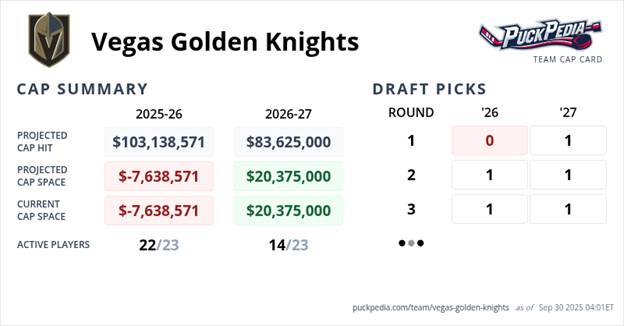
Projected Roster as of Sept 30 on PuckPedia.com
Season Ending LTIR candidate: Alex Pietrangelo ($8.8M)
Unsigned RFA: Alexander Holtz
LTIR moves: The key for Vegas is that Alex Pietrangelo signs off on Season Ending LTIR, making him ineligible to return during the regular season and playoffs. If he is just on regular LTIR, Vegas can only exceed the cap by the LTIR benefit limit of $3.8M, which would mean they need to clear $3.8M of cap hit to submit a cap compliant opening roster. That seems highly unlikely, so we’re expecting Pietrangelo goes on SELTIR. In that case, Vegas can exceed the cap by his full $8.8M, and since they’re currently only projected to be $7.64M over the cap, they can spend another $1,161,429. It’s no coincidence that unsigned RFA Holtz is in camp on a PTO; we’d expect him to sign a contract that utilizes almost all this availability. Remember that however much Vegas exceeds the cap on the opening submission is their LTIR pool and they start with zero space, so this $1.16M is either used before the opening roster submission or it is lost.
LTIR candidates: Matthew Tkachuk ($9.5M), Tomas Nosek ($775K)
Season Ending LTIR Candidate: Aleksander Barkov ($10M)
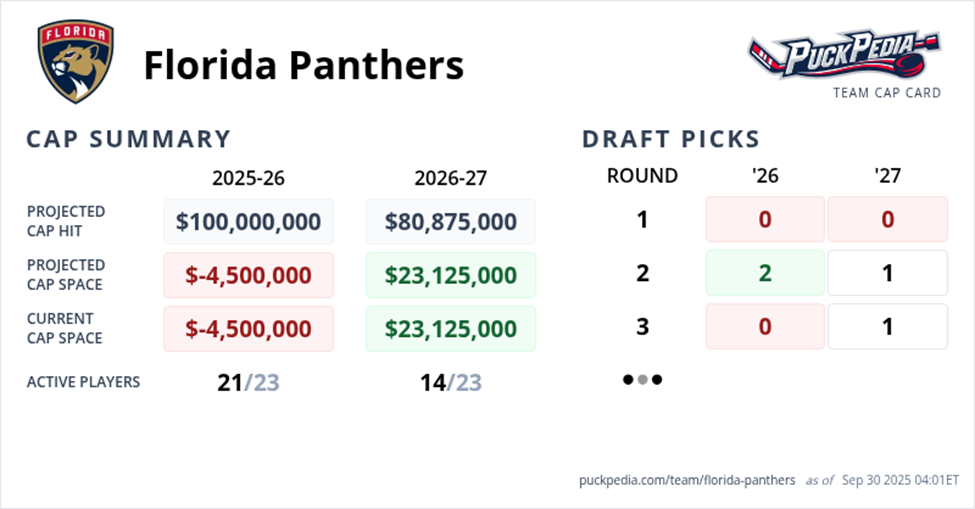
Projected Roster as of Sept 30 on PuckPedia.com
LTIR moves: The big news from training camp was the Barkov injury, which will keep him out 6-9 months. That means that it is possible he could return for the playoffs, but also possible he won’t be ready. The good news for Florida is that they can punt that decision on Barkov down the road. If they start with Tkachuk on LTIR (LTIR benefit limit of $3.8M) plus Nosek ($775K), they can exceed the cap by $4,592,293. The current projected roster is $4.50M over the cap, meaning it is within $92K of the optimal LTIR capture. That means they can start with those 2 on LTIR, submit the roster, have 0 space, and then add Barkov to regular LTIR. That would then give them another $3.8M of space (the LTIR benefit limit) to use, without having to decide on Barkov. At some point this season, they could move him to SELTIR, and bump that $3.8M up to his cap hit of $10M. That would allow them to be major players in the trade market, but it would make Barkov ineligible for the playoffs.
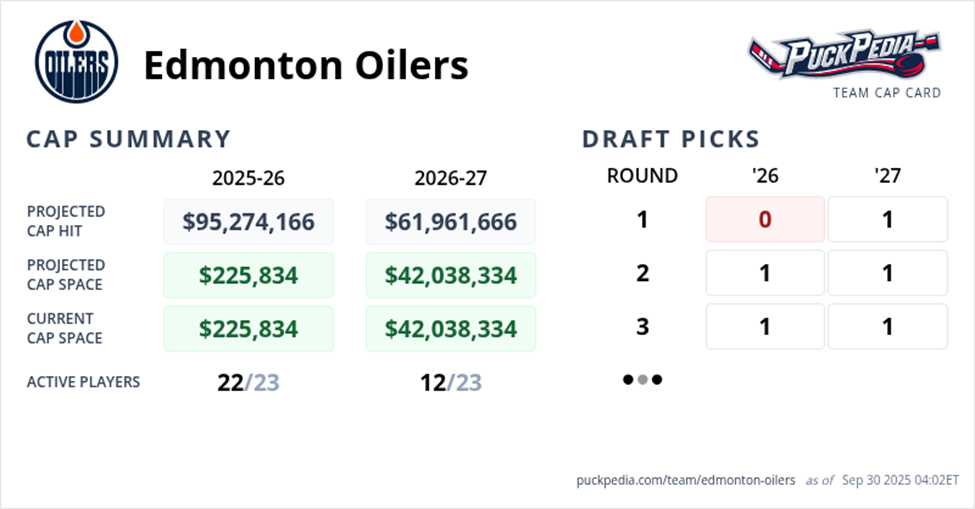
Projected Roster as of Sept 30 on PuckPedia.com
LTIR candidates: Zach Hyman ($5.5 million)
LTIR moves: Since Hyman is expected to return in a month, Edmonton could use LTIR to start the year and hope to be out of it after a month and begin accruing space. With the current projected roster, there is $226K of Projected Cap Space. If they use LTIR for 30 days instead of accruing space, that would reduce their available cap hit they can add at the deadline by $160K. That’s something, but not a huge loss, so it’s quite possible Edmonton does use LTIR to exceed the cap while Hyman is out.
Given they’re at 22 healthy skaters and under the cap, Edmonton would need to use the method of being under the cap for opening roster submission, then add Hyman to LTIR, and be able to exceed the cap by $3.8M (the LTIR benefit limit) less the cap space at the time they put him on LTIR. The current projected roster has Howard, Savoie, Stecher, and Lazar on the roster, with Jones, Regula and Philp waived and sent down. The final roster could look different, but 2 of Howard, Savoie, Stecher, Lazar, Regula, Janmark, Tomasek, and Philp need to be sent down in addition to Jones. The combination of players would leave them with $225K to $600K of space, meaning if they subsequently put Hyman on LTIR, they would be able to exceed the cap by $3.2 to $3.6M.
PuckPedia has exclusive reporting that the new restriction on “paper” moves in the new CBA does not apply until October 10. The rule states that players being sent down must play 1 AHL game prior to being recalled. This rule not being in effect for opening rosters has a direct impact on the Oilers. If the Oilers are worried about losing players on waivers, they could send down waiver exempt Savoie, Howard, and Tomasek on Oct 6 (opening rosters). That would keep Regula and Philp on the roster and give them $512.5K of cap space with 22 healthy players. They could then put Hyman on LTIR and have $3.3M of space; they could then recall Howard, Tomasek, and/or Savoie on Day 1 for cap purposes (Oct 7) and have them in the lineup for the Oilers first game. The caveat is that a team can only have 23 active players, so in that scenario, to get both players back up 1 player on the roster would need to go on Injured Reserve (Walman and Janmark have not played of late due to injury and several players are reportedly ill).
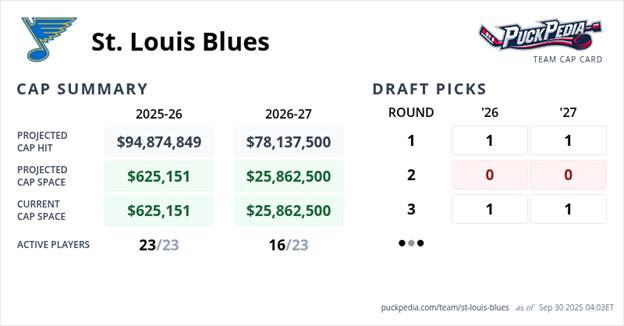
Projected Roster as of Sept 30 on PuckPedia.com
Season Ending LTIR candidate: Torey Krug ($6.5M)
Players to sign: Milan Lucic (PTO)
LTIR moves: St. Louis knows that Krug is not playing this season, so he’s eligible for Season Ending LTIR and relief for his entire $6.5M cap hit. They’re currently projected to be $625K under the cap, so they could submit the opening roster like that, add Krug to SELTIR, and then exceed the cap by $5.9M. They could also look at some roster juggling to get closer to the cap so that their LTIR pool is closer to $6.5M.

Projected Roster as of Oct 1 on PuckPedia.com
LTIR candidates: Stefan Noesen ($2.75M), Jonathan Kovacevic ($4M)
Season Opening IR (SOIR): Marc McLaughlin $189,714
LTIR moves: With Hughes signed at $9M, New Jersey has more certainty on their cap situation. We currently project them to be $3.98M over the cap with 23 healthy players. Just putting Kovacevic on LTIR would allow them to exceed the cap by the LTIR benefit limit of $3.82M, so that leaves them a little short. An obvious solution is Marc McLaughlin's $190K pro-rated SOIR Cap Hit. If he's expected out for 24 days past opening day, he could be added to LTIR as well. McLaughlin's $190K Cap Hit plus Kovacevic $3.82M would allow New Jersey to exceed the cap by up to $4,007,007; the current roster is $3,983,047, so they are within $24K of the optimal LTIR capture. At that point, they could add Noesen to LTIR to gain an additional $2.75M of cap space. If McLaughlin is not a candidate for LTIR, they compared to our roster projection they would need to send 1 down and include a player with $166K lower cap hit. Or they could just go with 22 healthy players and be about $3.2M over the cap, and be $600K away from an optimal capture. If everyone were to be healthy later in the season, they need to find a way to shed the amount they're over the cap.
New York Islanders – They have $650K of Projected Cap Space. It sounds like Varlamov ($2.75M) could be out for some time, while Engvall ($3M) is likely a shorter absence. At this point it seems unlikely they would put someone on LTIR to start the year, but being so close to the cap, if anyone is out long-term and they run out of space, they’re poised to access LTIR and with a little juggling could do so with a pretty optimal LTIR capture.
Watch for the teams making roster moves through the Oct 6 roster submission and see the final rosters on PuckPedia.com.







